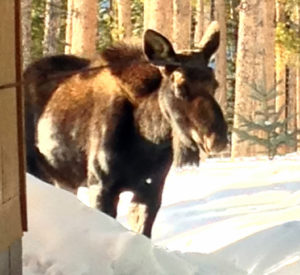
WARNING: Do not read this article if you’re eating. Seriously.
We’d just spend a lovely long weekend on the Front Range, and when we returned home we were greeted by, well, to be blunt, a heck of a lot of crap. The piles of little brown nuggets started at the entrance of our driveway and continued every few feet, leading to the front steps, and then moving on to below our deck. When we cautiously rounded the corner, there he was. A young bull moose, staring at us sheepishly. And then he refused to leave! He doggedly stood firmly rooted on the shoveled path we created for the dog, defiantly dropping even more shiny nuggets.
I don’t know if he invited friends over for a kegger while the parents were away, or if he somehow did it all himself, but there are twenty-five (that’s 25, veinticinco, XXV) piles of scat littered around the cabin. Honest, I counted. And then there’s the ridiculous amount of huge yellow blobs marring the once pristine snow. Now, you’re probably wondering how he managed to produce all this waste. I’m sorry, I just can’t make myself document my tale of woe about what happened to all the trees I’ve lovingly nurtured over the years. Stinkin’ moose!
While having the opportunity to get up close and personal to the poop we were shoveling up, I got curious about the consistency. It’s perfectly formed, like chocolate covered almonds or giant cappuccino-flavored jelly beans (I said it looks like, not tastes like candy). But your mind just has to wonder what happens inside a moose cavity to produce something that’s admittedly kind of pretty.
Moose, which is Algonquin for “twig eater,” have a similar digestive system as a cow. They are ruminants, meaning they’re mammals who are able to acquire nutrients from plants by fermenting it in one part of their four-chambered stomach. Chewing their cud for up to eight hours a day to break down my decimated aspens and evergreens is all part of the process.
In the summer, moose need to eat thirty to forty pounds of vegetation a day. I’ve cleaned up moose poop then, and it’s a very different consistency than what’s lying around my property now. That’s because in the summer, moose eat wet leafy foliage, which causes the nuggets to soften and glom together. The scat comes out looking like a cow patty, and many people confuse it with bear scat. (Old joke: how can you tell the difference? Bear scat smells like pepper spray and has a little bell in it.) Seriously, bears are omnivores and have simpler digestive systems. When examining their scat, you’ll find more undigested stuff like berries, leaves, hair, etc.
I don’t have to tell locals that Grand Lake winters are long. Our moose will lose up to 25% of their body weight since food isn’t as plentiful—unless a certain lucky youngster spends his spring break at Casa de Kroepfl. Funny, I don’t remember inviting him to stay.
This article was originally published in The Boardwalk newspaper, Grand Lake, Colorado.